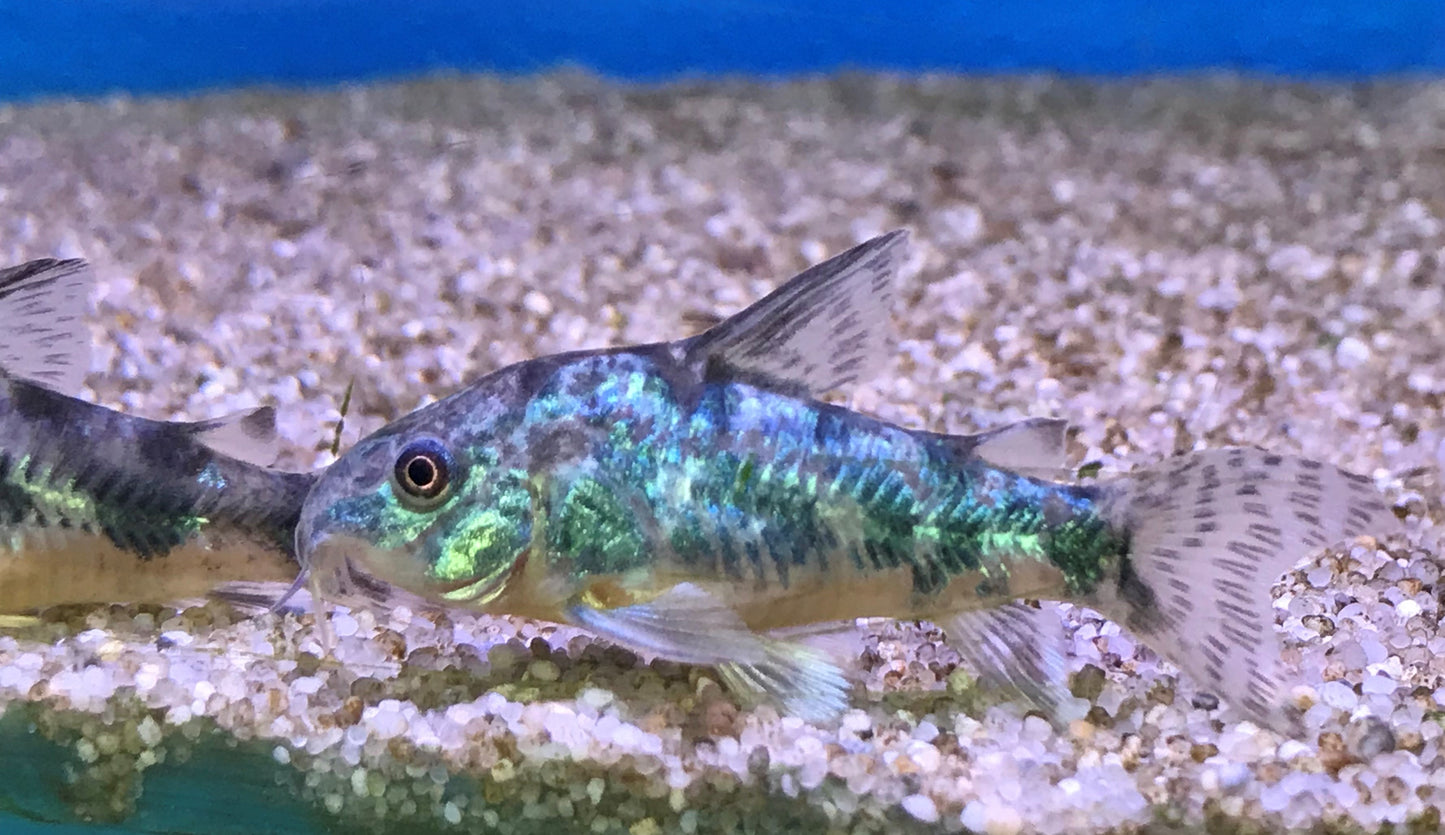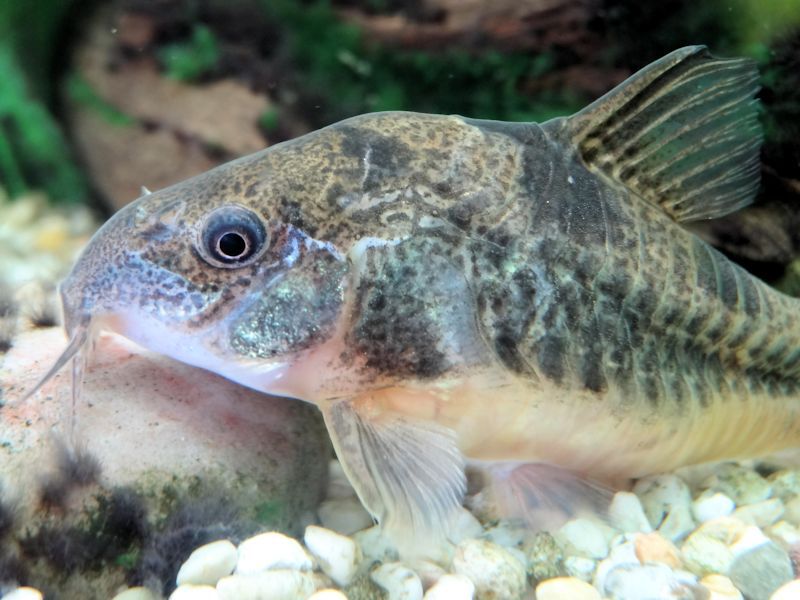Peppered Cory (Corydoras Paleatus) - Live Fish
Peppered Cory (Corydoras Paleatus) - Live Fish
Total items
Product subtotal
Detailed Description
Detailed Description
The Peppered Cory, also known as the Peppered Corydoras or Corydoras paleatus, is a small, peaceful species of freshwater fish in the Corydoras genus. It is one of the most popular species of Corydoras catfish due to its hardy nature, unique appearance, and calm temperament, making it a great addition to community aquariums. Native to the rivers and streams of South America, particularly in countries like Brazil, Argentina, and Uruguay, this species thrives in groups and is known for its playful behavior and scavenging habits.
Here’s a detailed look at the Peppered Cory:
1. Appearance
- Coloration: The Peppered Cory has a light gray to silver body covered with small, dark spots or speckles, which give it a "peppered" appearance. The body color can sometimes appear slightly greenish or brownish, and the speckles can be more prominent or less visible depending on the environment and lighting.
- Size: The Peppered Cory is a relatively small species, typically growing to about 2.5 to 3 inches (6-7.5 cm) in length, making it a great option for smaller aquariums or community tanks.
- Body Shape: It has a compact, robust body with a slightly flattened underside, which is characteristic of most Corydoras species. The fins are short and round, and its whisker-like barbels on either side of its mouth help it search for food on the substrate.
- Eyes and Mouth: It has large, round eyes and a small mouth located on the underside of its head, perfect for scavenging food from the bottom of the aquarium.
2. Temperament
- Peaceful and Social: The Peppered Cory is an extremely peaceful fish, making it an excellent choice for community tanks. It is non-aggressive and typically gets along with most other fish species, especially those of a similar size and temperament.
- Schooling Fish: Like other Corydoras species, the Peppered Cory is a schooling fish and should be kept in groups of at least 6 or more individuals. Keeping them in schools helps reduce stress and encourages natural behavior, such as foraging together and swimming in unison.
- Bottom Dwellers: Peppered Corys are bottom-dwelling fish, spending most of their time near the substrate, where they search for food and hide in crevices. They are active but usually stay close to the bottom or mid-levels of the tank.
3. Habitat
- Tank Size: Peppered Corys are small and do well in aquariums of various sizes. A 10-gallon (38 liters) tank is sufficient for a small group, though a 20-gallon (75 liters) tank is recommended for a larger group or when housed with other species.
-
Water Conditions: Peppered Corys are hardy and can tolerate a variety of water conditions. However, for optimal health, they prefer:
- pH range: 6.0 to 7.5 (slightly acidic to neutral)
- Temperature range: 72-79°F (22-26°C)
- Soft to moderate hardness: They can tolerate moderate hardness but do best in softer water.
- Filtration and Water Quality: Corydoras are sensitive to poor water quality, so good filtration is essential. Regular water changes (around 25-30% per week) will help maintain the cleanliness of the tank. These fish are also sensitive to ammonia and nitrite levels, so it's crucial to maintain stable, healthy water parameters.
- Substrate: As bottom dwellers, Peppered Corys appreciate a smooth substrate (such as fine gravel or sand) since they are prone to injuring their delicate barbels on rough surfaces. A soft substrate mimics their natural environment and allows them to forage without harm.
- Tank Décor: Provide plenty of hiding spots such as rocks, driftwood, and plants. While they don't require a heavily planted tank, plants can provide extra cover and help create a natural habitat.
4. Diet
-
Omnivorous: The Peppered Cory is an omnivore, meaning it will eat a wide variety of foods. In the wild, they feed on small invertebrates, detritus, and plant matter. In captivity, you should provide a varied diet that includes:
- High-quality pellets or flakes formulated for bottom feeders.
- Live or frozen foods like bloodworms, brine shrimp, or daphnia.
- Vegetables, such as blanched spinach, zucchini, or peas.
- Algae wafers or sinking pellets, which cater to their scavenging habits.
- Feeding Behavior: Peppered Corys are opportunistic feeders and will scavenge for food on the tank floor. They often prefer to eat after the other fish have had their fill, making them excellent clean-up crew members for your aquarium.
- Feeding Frequency: Feed them once or twice a day. It's essential to avoid overfeeding, as uneaten food can lead to water quality issues.
5. Behavior and Care
- Active and Social: Although they are bottom-dwellers, Peppered Corys are quite active, especially when kept in groups. They often scavenge together and enjoy exploring their environment. They may also occasionally swim to the mid-levels of the tank.
- Hardy: One of the reasons the Peppered Cory is so popular is its hardy nature. It can adapt to a range of water conditions and is generally easy to care for, making it an ideal fish for beginners.
- Lifespan: With proper care, Peppered Corys can live up to 5-7 years in captivity.
6. Breeding
-
Breeding in Captivity: Peppered Corys are relatively easy to breed in captivity, though they do require specific conditions to spawn. To encourage breeding:
- Provide a breeding tank with a fine substrate and gentle filtration.
- Maintain slightly cooler water (around 72°F/22°C) and perform a large water change to simulate the rainy season.
- Spawning Behavior: During spawning, females will lay eggs on flat surfaces, and males will fertilize them. The eggs hatch in about 3-4 days.
- Caring for Fry: Once the fry are free-swimming, they can be fed infusoria or baby brine shrimp until they are large enough for crushed flakes or pellets.
7. Tankmates
-
Peaceful Community Fish: Peppered Corys are very peaceful and do well with a variety of other community fish. Good tankmates include:
- Tetras, Rasboras, and Guppies.
- Smaller Livebearers, such as Mollies, Swordtails, or Platies.
- Other Corydoras species (they often do well with other types of Corydoras).
- Peaceful Gouramis, Danios, and Barbs (make sure they are non-aggressive).
- Avoid Aggressive Fish: Aggressive or fin-nipping species (like some types of Cichlids or aggressive Barbs) should be avoided.
8. Considerations
- Barbel Care: Corydoras fish rely on their sensitive barbels to search for food on the substrate. Ensure the substrate is smooth to prevent injury to these delicate barbels.
- Water Quality: Regular water changes and good filtration are essential to maintain optimal water quality for Peppered Corys. They are especially sensitive to poor water conditions and will not thrive in tanks with high ammonia or nitrite levels.
- Schooling Behavior: For the well-being of the fish, it is important to keep at least 6 Corys in a group. Keeping them in smaller groups may cause stress and reduce their natural behavior.
The Peppered Cory is a peaceful, hardy, and active fish that makes an excellent addition to community aquariums. Its playful nature, easy care requirements, and charming appearance make it a great choice for both beginners and experienced hobbyists. When kept in groups and provided with clean water, a suitable substrate, and a varied diet, Peppered Corys can live for many years and add both beauty and function to your aquarium as part of the clean-up crew.
Product features
Product features
Materials and care
Materials and care
Merchandising tips
Merchandising tips
Share








